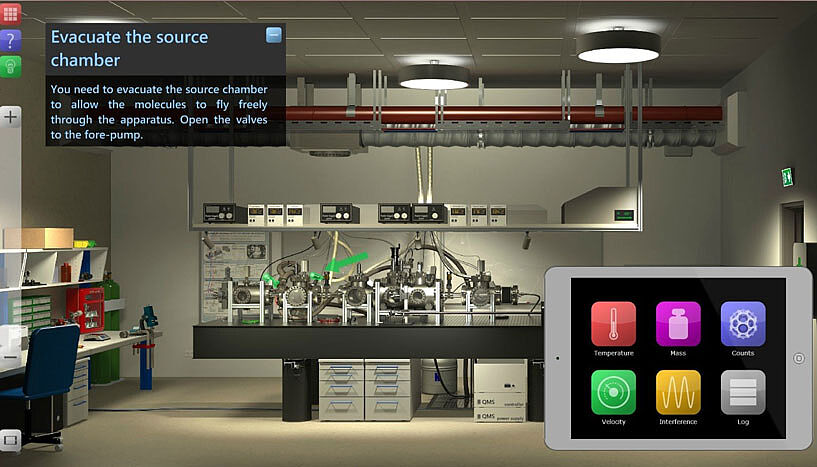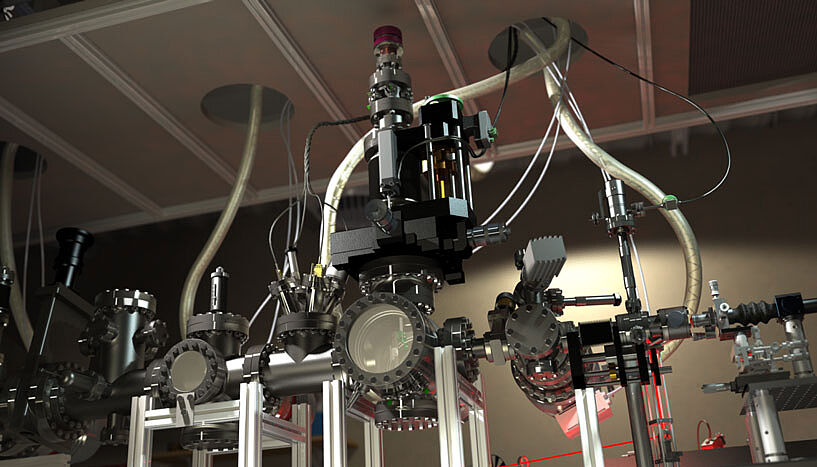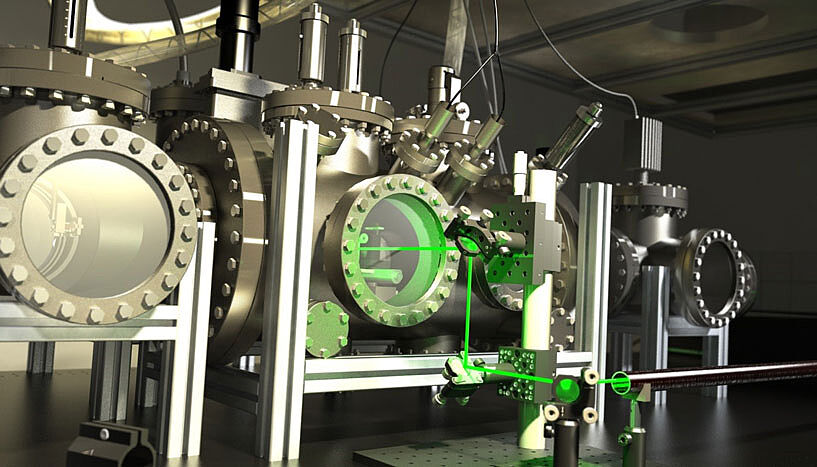A quantum lab for everyone
16. September 2015Modern science as a photorealistic online game
A virtual laboratory allows, for the first time, to actively engage with topical quantum physics. The novel learning environment was developed at the Faculty of Physics at the University of Vienna in collaboration with university and high-school students. In time for the start of the new term, the virtual quantum lab is freely available online (http://interactive.quantumnano.at). The new teaching concept has been published in the journal "Scientific Reports".
Modern science for all
Topical research experiments are often too expensive or too complex to be rebuilt and incorporated in teaching. How can one, nevertheless, make modern science accessible to the public? This challenge was tackled in the research group Quantum Nanophysics led by Markus Arndt at the University of Vienna. For the first time, two research laboratories were created as complete, photorealistic computer simulations allowing university and high-school students as well as the general public to virtually access unique instruments. "One could describe it as a flight simulator of quantum physics", says Mathias Tomandl who designed and implemented the essential elements of the simulation in the course of his PhD studies.
Discovering the quantum world – step by step
A learning path guides the visitors of the virtual quantum lab through the world of delocalized complex molecules. A series of lab tasks and essential background information on the experiments enable the visitors to gradually immerse into the quantum world. The engaging software was developed together with university and high-school students and was fine-tuned by periodic didactic input. The teaching concept and the accompanying studies have now been published in the renowned scientific journal "Scientific Reports".
Wave-particle dualism with large molecules
The virtual laboratories provide an insight into the fundamental understanding and into the applications of quantum mechanics with macromolecules and nanoparticles. In recent years, the real-life versions of the experiments verified the wave-particle dualism with the most complex molecules to date. Now, everyone can conduct these experiments in the virtual lab for the first time.
The quantum lab on tour through Austria
Currrently, a light version of the virtual lab can be experienced as an interactive exhibit in the special exhibition "Das Wissen der Dinge" in the Natural History Museum Vienna. In the travelling exhibition
"Wirkungswechsel" of the Science-Center-Netzwerk the exhibit will be available at various locations throughout Austria.
Acknowledgements
We acknowledge the support by the Vienna Business Agency ZIT (957475), the Austrian Science Fund FWF (Z149-N16 and WKP-16) and the European Research Council (ERC 320694).
Publication in "Scientific Reports":
Simulated Interactive Research Experiments as Educational Tools for Advanced Science;
Mathias Tomandl, Thomas Mieling, Christiane M. Losert-Valiente Kroon, Martin Hopf & Markus Arndt. Scientific Reports 5, 14108 (2015)
doi:10.1038/srep14108
www.nature.com/articles/srep14108
Further information
Video – interactive quantum lab: https://www.youtube.com/watch?v=3vPSFotrmME
Special exhibition "Das Wissen der Dinge": http://www.nhm-wien.ac.at/ausstellung/sonderausstellungen/das_wissen_der_dinge_1
Travelling exhibition "Wirkungswechsel": http://www.wirkungswechsel.at/
Wissenschaftlicher Kontakt
Univ.-Prof. Dr. Markus Arndt
Gruppensprecher Quantenoptik, Quantennanophysik und QuanteninformationUniversität Wien
1090 - Wien, Boltzmanngasse 5
+43-1-4277-512 10
markus.arndt@univie.ac.at
Rückfragehinweis
Stephan Brodicky
Pressebüro der Universität WienUniversität Wien
1010 - Wien, Universitätsring 1
+43-1-4277-175 41
+43-664-60277-175 41
stephan.brodicky@univie.ac.at
Downloads:
interaktives_Quantenlabor_01.jpg
Dateigröße: 228,52 KB
Beugung_von_Molekuelen_01.png
Dateigröße: 1,95 MB
Interferenz_komplexer_Molekuele_01.jpg
Dateigröße: 230,69 KB



